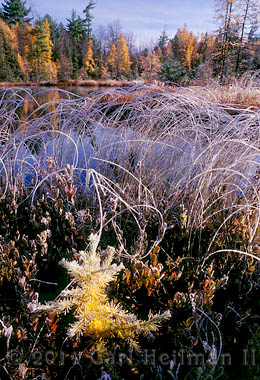In the Adirondacks, the colors of autumn both begins and ends in the wetlands. In mid September, almost two weeks before the surrounding hillsides reach peak color, red maples (swamp maples) in the many wetlands throughout the region, turn a fiery red color, signifying the beginning of the foliage season. Within a week or so after these leaves have turned and dropped, reducing the trees to a collection of bare branches and stems, the maples on the hillsides come alive with varying shades of yellow and red. Following this, beech leaves turn yellow and red oaks sport a crimson tone before all the colors fade to brown. Then, last but certainly not least – almost 8 weeks after the first red maples changed color, the soft, delicate needles of the larch, turn to a beautiful yellow-gold tone.
 Larch are the only coniferous trees that anually lose all of their needles. This happens each year about a full 6 weeks after white pines have shed the previous year’s layer of needles. One of the great things for photography is that the the larch turns at a time of year when there is a good likelihood for heavy morning frost to add a silver edge onto each golden needle of the tree. With the abundance of moisture found in a wetland, the icing can build into a frosting that almost completely covers all the needles. As the sun rises above the horizon and slowly burns away the mist, the ice coated needles shine with a vivid golden glow in the first warm light of the day.
Larch are the only coniferous trees that anually lose all of their needles. This happens each year about a full 6 weeks after white pines have shed the previous year’s layer of needles. One of the great things for photography is that the the larch turns at a time of year when there is a good likelihood for heavy morning frost to add a silver edge onto each golden needle of the tree. With the abundance of moisture found in a wetland, the icing can build into a frosting that almost completely covers all the needles. As the sun rises above the horizon and slowly burns away the mist, the ice coated needles shine with a vivid golden glow in the first warm light of the day.




